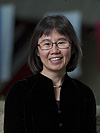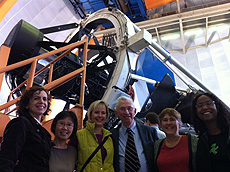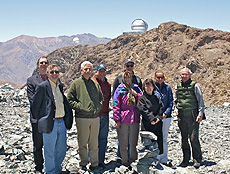Celebrating the DECam and CTIO's 50th birthday
 |
Fermilab Deputy Director
Young-Kee Kim
|
On Nov. 9 I joined a delegation of Fermilab scientists and DOE colleagues to celebrate the dedication ceremonies for the Dark Energy Camera, held during the kick-off of the 50th anniversary of the Cerro Tololo Inter-American Observatory. The more than 100 attendees included collaborators and representatives from all the Dark Energy Survey institutions, as well as CTIO and National Optical Astronomy Observatory staff. Unfortunately, Pier was not able to be there because he was attending the graduation of our latest group in the Strategic Laboratory Leadership Program.
The dedication ceremonies began with a tour of the Blanco Telescope and the DECam. A group of excellent speakers from NOAO, CTIO, Fermilab and University College London then told the fascinating history of the CTIO, of the formation of the DES collaboration and of the many challenges and successes that faced DECam's construction and installation.
Funded by NSF and managed by the NOAO, the CTIO is an astronomical observatory located on Cerro Tololo near the Atacama Desert of northern Chile, approximately 50 miles east of La Serena, where the support facilities are located. Of the numerous achievements made by the telescopes at the CTIO, I mention only that much of the early work by the two main groups who made the discovery of the accelerating universe was carried out at the Blanco Telescope.
DECam, a 570-megapixel camera mounted on the Blanco Telescope, is the world's most powerful digital camera. It was constructed at Fermilab by the DES collaboration of more than 130 scientists from 27 institutions with support from DOE, NSF, funding agencies in Brazil, Germany, Spain, Switzerland and the UK, and partner DES institutions. With this device, roughly the size of a phone booth (for those of you who remember phone booths!), scientists will probe the mystery of dark energy, the force that could be causing the universe to expand at ever-increasing speeds. The Dark Energy Survey is expected to begin in December, after the camera has been fully tested. It will take advantage of the excellent atmospheric conditions in the Chilean Andes to create the deepest, sharpest pictures ever achieved in such a wide-field astronomical survey. In its first few nights of testing in September, the camera already delivered incredible images with excellent, nearly uniform spatial resolution.
The morning following the dedication ceremony, I attended a DES Council meeting where we discussed the commissioning work needed before the survey can commence and visited Gemini South, an observatory consisting of a roughly 8.2-meter telescope, and the site of the Large Synoptic Survey Telescope on Cerro Pachón, about 7 miles from Cerro Tololo. LSST excavation work is proceeding well.
Clearly the scientific highlight of the trip was seeing the Blanco Telescope and the DECam - a testament to the power and vigor of a successful international collaboration. The personal highlight was to perceive the forces of nature written indelibly in the night sky as can only be properly experienced on a distant mountain top in the middle of a cold clear night.
 |
Five women scientists and former Fermilab Director John Peoples in front of the DECam. From left: Kathy Turner (DOE), Young-Kee Kim (Fermilab), Natalie Roe (LBNL), John Peoples (Fermilab), Brenna Flaugher (Fermilab), Marcelle Soares Santos (Fermilab). Photo: Craig Hogan
|
 |
A group tours the future site for the LSST. The telescope domes seen in the back are SOAR and Gemini-South. From left: Christopher Smith (AURA), Peter Garbincius (Fermilab), Craig Hogan (Fermilab), David Silva (NOAO Director), Kathy Turner (DOE), Josh Frieman (Fermilab), Young-Kee Kim (Fermilab), Nicole van der Bliek (CTIO Director), Rob Pennington (NCSA). Photo: Jean Garbincius
|
|